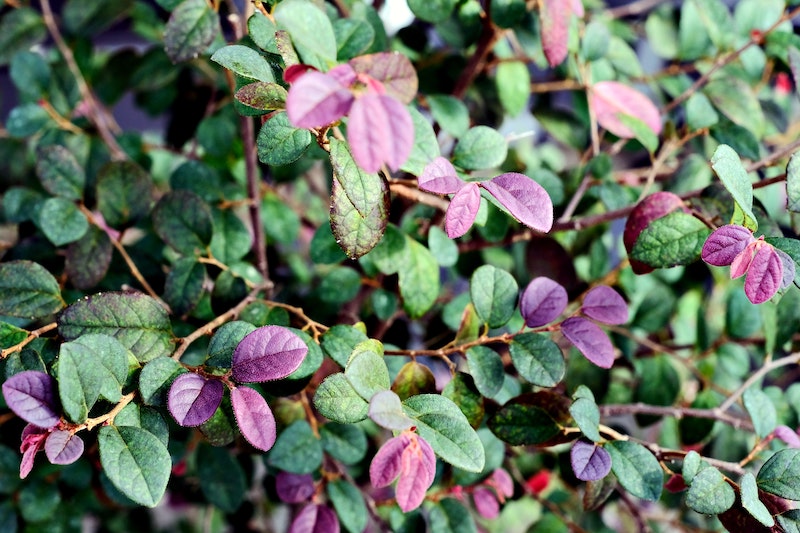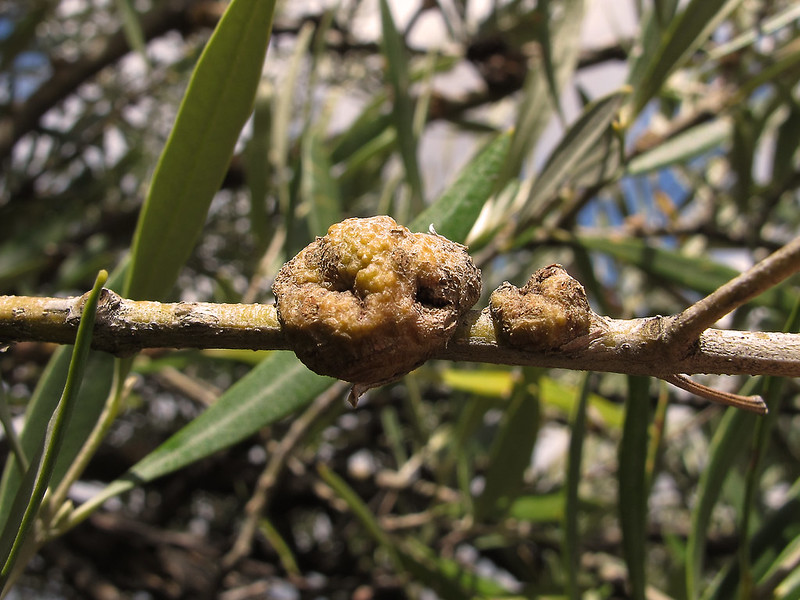Loropetalum, commonly known as Chinese fringe flower, is regarded as a relatively easy shrub to grow and thrives in the warmer USDA growing zones of 7-10. There are a few bacterial and fungal diseases that can cause problems such as leaf spot, root rot, powdery mildew of the foliage, and persistent gall infections. While some of these diseases can be fatal if left untreated, with quick diagnosis and treatment, there is a very good chance that your plant will recover with little lasting damage.

Olive Gall
Olive gall is caused by the bacteria Pseudomonas savastanoi and attacks not only Loropetalum chinensis but also olive trees, forsythia, and ash trees. The disease is transmitted in warm weather by splashing water from rain or overhead watering. The Pseudomonas bacteria are present in soil and on some types of trees or shrubs, facilitating the spread of this disease between plants. The virus is often spread by bringing infected plants into the garden or failing to sterilize tools while tending to infected plants. If the disease is contained to just lateral shoots and stems, the plant may survive treatment. Any galls growing on the main stem indicate that the plant will eventually die no matter what treatment is done.
Identifying Olive Gall
Knotted and weeping lesions appear on the stems and branches of the shrub. Galls grow in size as the disease progresses, eventually girdling the whole stem, cutting off the flow of phloem and xylem in the shrub. The affected stem will die back. The bacteria will enter any damaged parts of the plant and will quickly begin to form galls. When the lesions are actively weeping, during the growing season, bacteria can be easily spread to healthy plant tissue by overhead watering or using infected pruning tools.

Photo by Jacinta Lluch Valero, Flickr, Copyright CC BY-SA 2.0
Treating Olive Gall
The main treatment for Olive Gall is to cut out as much affected plant material as possible. The time to do this is when the shrub (and the bacterial infection) is dormant in late winter, just before bud break. Make sure to cut far enough below the galls so that all infection is removed. Do not bring obviously infected plants into the garden. Plants in the bargain bin are not a great deal if they are infected by diseases. Always quarantine any suspect plants you bring home to ensure they are healthy. Avoid any overhead watering in the beds you grow Loropetalum. Drip irrigation or soaker hoses are much more efficient, saving both money and water over time. Make clean cuts when pruning and disinfect your pruners between plants or even cuts if the Pseudomonas bacteria is common in your gardening zone. Make thinning cuts to allow for good air circulation inside and around shrubs that are planted close together, such as a hedge or ground cover.
Anthracnose
Anthracnose is a fungal disease that causes blight symptoms on the leaves of many different plants. Anthracnose on Loropetalum appears after new growth begins in a rainy spring. The fungus needs warmish temperatures and moisture to move from plant to plant. Often the fungus overwinters on infected leaves left on the ground. An Anthracnose infection may not occur every year, depending on how warm and wet the spring is. During dry or cool springs, no damage may be seen, leading gardeners to think the disease is gone. Plants that are repeatedly infected year after year will have severely reduced vigor and flowering abilities.
Identifying Anthracnose
The young leaves will have sunken brown or black lesions. The tips of branches may turn black as well and die back. Leaf distortion and stunting are also early signs of the disease. Healthy, mature plants may be able to withstand infection for several years before they decline in health.
Treating Anthracnose
Soils that drain poorly are one reason for the spread and infection of plants. Improve drainage or move the plant to a better location. Loropetalum in too much shade or growing in soil that is not acidic enough will also be susceptible to infection. Cut out any affected plant material to prevent the spreading of the disease. Do not compost this plant material. Burn or dispose of in the trash to prevent the spread of the fungus. Pruning to increase air circulation also helps the leaves to dry faster in the spring from heavy rains.
Powdery Mildew
Powdery mildew prefers cool nighttime temperatures followed by warm days, making spring and fall the most likely seasons to see this fungal disease. Powdery mildew attacks younger plants more severely than mature shrubs. In gardens that are heavily shaded, powdery mildew can spread quickly. Overhead watering and failure to remove affected plant material also allow the fungal spores to spread. Often, powdery mildew late in the season is considered more of a nuisance or an aesthetic problem than a serious disease. With good garden sanitation, trees and shrubs can overcome an outbreak and grow healthily the following year.
Identifying Powdery Mildew
This disease presents as white or silvery marks on leaves. Small blotches of the fungal spores will spread to the whole leaf, both top and bottom. If left untreated, the fungus will eventually attack all of the green leaves it contacts. When an outbreak happens early in the season, new leaf growth may be twisted and distorted. Eventually, infected leaves will turn brown and drop from the plant.

Photo by Scot Nelson
Treating Powdery Mildew
Removing leaves as they appear is one way to control powdery mildew. Fungicidal sprays and powders may help protect healthy parts of the shrub but do not eradicate the disease. Repeated applications are needed, especially after heavy rains. Removing leaf debris in the fall will prevent the spores from overwintering near your shrub. Do not fertilize infected trees or shrubs unless absolutely necessary. Overfertilization can promote excessive, weak, foliage growth. Prune to allow air circulation inside the shrubs and between plants.
Leaf Spot
Leaf spot can be caused by both fungal and bacterial pathogens. The good news is that all leaf spot diseases present with similar symptoms and are treated with the same mechanical and cultural techniques. While most leaf spot diseases are species specific, just about every tree and shrub can be affected by this class of diseases. Most trees and shrubs with leaf spot can survive and can live for many years with little management to keep it from spreading.
Identifying Leaf Spot
The lower leaves will be the first to show signs of an infection. Dark brown or yellow spots may appear on the upper side of the leaves. There may be a variety of spot sizes and shapes depending on the disease stage. Affected leaves may drop prematurely. If premature leaf drop happens for three or more consecutive years, the health of the shrub may be compromised.
Treating Leaf Spot
Rake up and dispose of any fallen foliage promptly. Do not leave leaf debris on the ground over winter. Plant shrubs at an appropriate distance to avoid overcrowded growing conditions. Avoid overhead watering, which allows diseases to spread easily. Soaker hoses and drip irrigation are the best ways to water any plant in the garden. Fungicides will only work to prevent the spread of disease to healthy plant material. Unless the shrub is short enough to be sprayed safely and easily, fungicides are not very effective in treating leaf spot.
Root Rot
Root rot diseases occur where the soil does not have sufficient drainage or where plants are mismanaged and not given the conditions they need to thrive. Loropetalum is a low-maintenance shrub if planted in well-draining, slightly acidic soil. Soil that is too alkaline and soggy can become a breeding ground for root rot pathogens, leading to the demise of Loroptealum shrubs.
Identifying Fungal Root Rot
The symptoms of root rot can be deceiving. The top growth of the shrub may appear under-watered, with drooping stems and leaves, and potentially yellowing or browning of the leaves. In fact, the plant is not getting enough water because the root rot pathogen smothers the root system, limiting its access to nutrients and moisture. Soggy soils from seasonal flooding or excessive watering give the pathogens a place to live and infect the roots of stressed or already diseased shrubs.
Treating Fungal Root Rot
Proper drainage in the garden is the easiest way to protect plants from root rot. Move plants or install French drains if drainage is poor. Sometimes plants need to be grown in raised beds or containers if the drainage cannot be improved. Choose plant varieties with root rot resistance, and check new plants for early signs of root rot. Always take a new plant out of its pot and inspect the root system for signs of dark or rotten roots before planting.
Loropetalum Disease Chart
|
Disease |
Identifying |
Treating |
|
Olive Gall |
Knotted growths on stems that ooze liquid when the bacteria are present, distorted or reduced flowers |
Prune out affected plant material well below the infection |
|
Anthracnose |
Tan or yellow spots on leaves, early leaf drop, distorted leaf growth |
Avoid overhead watering, cut out affected plant material, and improve drainage |
|
Powdery Mildew |
White or silver ‘powdery’ coating on the tops of leaves |
Thin branches to improve air circulation; avoid overhead watering |
|
Leaf Spot |
Dark brown or black spots appear on both the top and bottom of affected leaves |
Improve soil drainage, avoid overhead watering, prune out affected plant material |
|
Root Rot |
Reduced growth and overall vigor, flowers fail to open or drop early, the plant seems to be in need of watering |
Ensure proper drainage is available year-round; remove and dispose of affected plants |
Sources: "Loropetalum chinense." The North Carolina Extension Gardener Plant Toolbox. plants.ces.ncsu.edu
 |
Author Robbin Small - Published 6-06-2023 |
